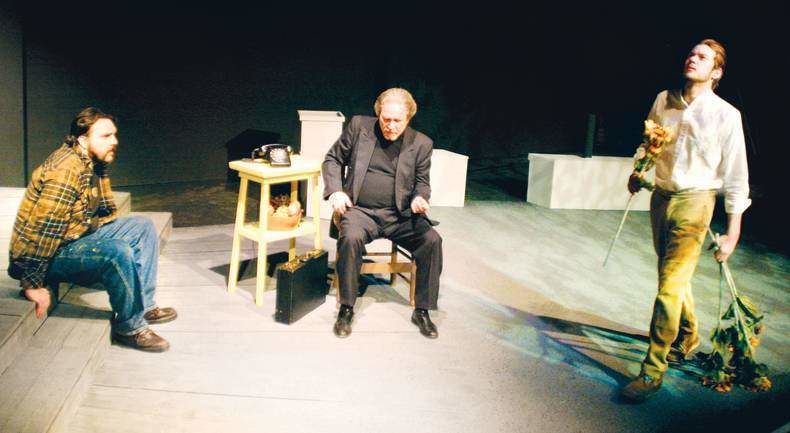Brush of reality
Published 4:00 am Friday, March 7, 2008

- Jared Rasic, Rod Dahl and Caleb Neet, from left, rehearse “Inventing Van Gogh” at the Cascades Theatrical Company.
Ask yourself what you know about artist Vincent van Gogh.
That he cut off his ear and drank turpentine are probably in your top-five factoids. For some of us, the suffering, passion and madness have all glommed together to form our idea of van Gogh and his art.
Playwright Steven Dietz sets out to separate the myths from realities of the 19th-century impressionist artist in the drama “Inventing Van Gogh,” a head trip of a play opening tonight at Cascades Theatrical Company in Bend (see “If You Go”).
In his author’s note at the beginning of the script, Dietz acknowledges the suffering the quintessential starving artist endured — delirium, poverty, loneliness and depression — but argues that in a world that loves messy endings, romanticizing van Gogh’s suffering has muddied his art.
“Still,” he writes, “the man went in a room and made a painting.” That’s not to dismiss the art, which this work treats with reverence.
The same can be said of van Gogh’s passion, reflected in the dialogue. “Just dash it on! The summit of wisdom is daring!” van Gogh (played by Caleb Neet) tells Patrick Stone (Jared Rasic), the play’s anti-hero.
Of course, wisdom’s nadir is reached when van Gogh wishes he’d “fallen ill and died” before he became a painter.
In modern terms, van Gogh was a mess, and he became famous for it in death. But “the suffering did not lift the brush,” Dietz remind us. “The artist did.”
His status increased posthumously among art aficionados, and collectors began canvassing Holland and France for missing van Goghs.
“As his fame grew, so too grew the ‘hunt’ for his work,” Dietz writes. “A frenzy ensued.” At least one rediscovered work had been used to patch a chicken coop, and inevitable fakes appeared, writes Dietz.
In the play, Patrick feels like something of a fraud himself. He’s a contemporary painter whose mysterious involvement in the suicide of his mentor, Dr. Miller, has left his creative well dry, if not his reserve of disdain for Miller’s personal obsession: van Gogh.
More specifically, Miller had searched high and low for van Gogh’s purported last self-portrait, a missing work painted in the throes of depression and madness. Miller never found it.
In the opening scene, Rene Bouchard (Rodney Dahl) shows up and commissions Patrick to paint that missing van Gogh. Irony of ironies: Bouchard is an art authenticator, or as Patrick sees it, “Destroyer of Masterpieces.” This is never quite explained, but two things are clear: Bouchard is powerful and sleazy, a pair of traits we wouldn’t want in our friends but love in our villains.
Bouchard’s elaborate scheme to sell the forgery sounds plausible enough. Vincent van Gogh really did paint in the neighborhood of 40 self-portraits; one conceivably could have gone missing, then surfaced in post-World War I Europe, only to languish in an old stone cottage in France for 80 years.
Scoffing Patrick sees the many gaps in the scheme, but Bouchard believes one “black hole” in the story could help his crooked cause: In the month before van Gogh’s death, there was a nine-day stretch in his otherwise meticulously documented painting life during which there’s no record of what van Gogh may have painted.
Like colors mixing on an artist’s palette, the play combines reality and fiction, and Patrick has hallucinations himself, of being visited by Miller (Cornelius Würschmidt), Paul Gauguin (Dahl again) and van Gogh.
As you can imagine, it’s a little awkward when Patrick tells van Gogh he doesn’t care for his work, which is “just crude juxtaposition and rabid application.” Ouch.
There are parallels drawn between van Gogh’s life and Patrick’s, including a woman who can’t seem to get between the artists and their canvases — in Patrick’s case, it’s Hallie; in van Gogh’s, it’s Marguerite (played in both cases by Jenn Copsey).
Patrick does undertake to forge a van Gogh, and he gets his comeuppance when van Gogh himself remarks that it’s not as good as the original: Miller’s life cause, the missing last self-portrait that Patrick never believed in anyway.
As time bends in a hallucinatory world, we see the demise of both Miller and van Gogh, while Patrick stays at the easel, feverishly painting. To say much more would spoil the just-messy-enough ending.
Dietz’s voice is sharp and has a way of drawing you in, even if you’ve never taken an art appreciation course in your life. The set is, by Dietz’s instruction, “aggressively theatrical,” a spare place consisting of easel, chair, desk, phone. It is, writes Dietz, intended to evoke van Gogh’s personal credo: “Exaggerate the essential; leave the obvious vague.”
IF YOU GO
What: “Inventing Van Gogh”
When: 7:30 p.m. Wednesdays through Saturdays, 2 p.m. Sundays, tonight through March 22
Where: Cascades Theatrical Company, 148 N.W. Greenwood Ave., Bend
Cost: $20 adults, $15 seniors, $10 students
Contact: 389-0803






